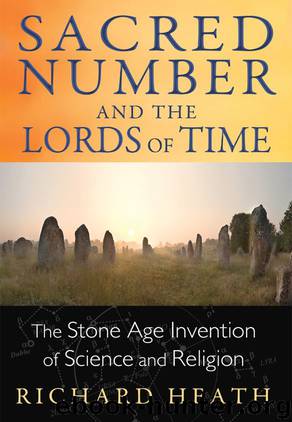Sacred Number and the Lords of Time: The Stone Age Invention of Science and Religion by Richard Heath

Author:Richard Heath [Heath, Richard]
Language: eng
Format: epub
Tags: Ancient Mysteries
ISBN: 9781620552452
Publisher: Inner Traditions/Bear & Company
Published: 2014-05-14T00:00:00+00:00
6
THE MEGALITHIC MODEL OF THE EARTH
THE MOST NATURAL approach in studying the Earth as a three dimensional object is as a perfect sphere. This means that an observatory circle, scaled to its parallel of latitude and to the equator, was a ready-made representation of the Earth both as the equator and as the meridian. Viewing the observatory circle as the Earth’s meridian would have enabled the geometry of the circle to give access to the circumferential length of different parallels of latitude by building right triangles relative to the center of the Earth. This method assumes a geocentric idea of latitude rather than one related purely to the stars. Once the length of the equator was known, the geocentric latitude could be calculated through the length of the parallel relative to the equator, measured in the usual way but now revealing itself within geometries that could be constructed within the observatory.
This way of measuring latitude, from estimating the circular length of a parallel of latitude on a spherical Earth, differs little in potential accuracy from measuring astronomical latitude and it had a key advantage for megalithic scientists. Establishing geocentric latitude did not rely on equipment pointing at the sky to measure angles on the horizon. Megalithic scientists could not “take measurements” as we do from a device (such as an instrument pointed at the sky) because they had no notation suitable to abstract measurements except as lengths. There always had to be a metrological means to store data and the large circles of observatories could deliver accurate angular measurements approaching the one minute of arc possible to the naked eye. Measuring latitude within a geometrical circle brought the measurement of the length of a parallel of latitude within the scope of triangular mechanisms, which could reveal angles. The megalithic form of notation for an angle was always the tangent (the drop angle) or the cosine, realized within a right triangle.
The example of Stonehenge in figure 6.1 shows the way in which geocentric latitude would be presented using the circular geometry of a geodetic observatory as well as how the length of the parallel at Stonehenge could be deduced. The radius of the parallel can be directly compared as a ratio to the radius established for the equator itself. One can form a right triangle where the hypotenuse is the equatorial radius and the base the radius of the parallel of latitude. This type of geodetic latitude measurement avoids sighting the north pole and the use of a pole star, which as we’ve previously discussed is a very rare phenomenon (see figure 6.2).
Download
This site does not store any files on its server. We only index and link to content provided by other sites. Please contact the content providers to delete copyright contents if any and email us, we'll remove relevant links or contents immediately.
The Daily Stoic by Holiday Ryan & Hanselman Stephen(3188)
The Fate of Rome: Climate, Disease, and the End of an Empire (The Princeton History of the Ancient World) by Kyle Harper(2970)
People of the Earth: An Introduction to World Prehistory by Dr. Brian Fagan & Nadia Durrani(2670)
Ancient Worlds by Michael Scott(2571)
Babylon's Ark by Lawrence Anthony(2483)
The Daily Stoic by Ryan Holiday & Stephen Hanselman(2416)
Foreign Devils on the Silk Road: The Search for the Lost Treasures of Central Asia by Peter Hopkirk(2400)
India's Ancient Past by R.S. Sharma(2360)
MOSES THE EGYPTIAN by Jan Assmann(2338)
The Complete Dead Sea Scrolls in English (7th Edition) (Penguin Classics) by Geza Vermes(2195)
Lost Technologies of Ancient Egypt by Christopher Dunn(2167)
The Earth Chronicles Handbook by Zecharia Sitchin(2146)
24 Hours in Ancient Rome by Philip Matyszak(2021)
Alexander the Great by Philip Freeman(2006)
Aztec by Gary Jennings(1924)
The Nine Waves of Creation by Carl Johan Calleman(1835)
Curse Tablets and Binding Spells from the Ancient World by Gager John G.;(1811)
Before Atlantis by Frank Joseph(1782)
Earthmare: The Lost Book of Wars by Cergat(1758)
